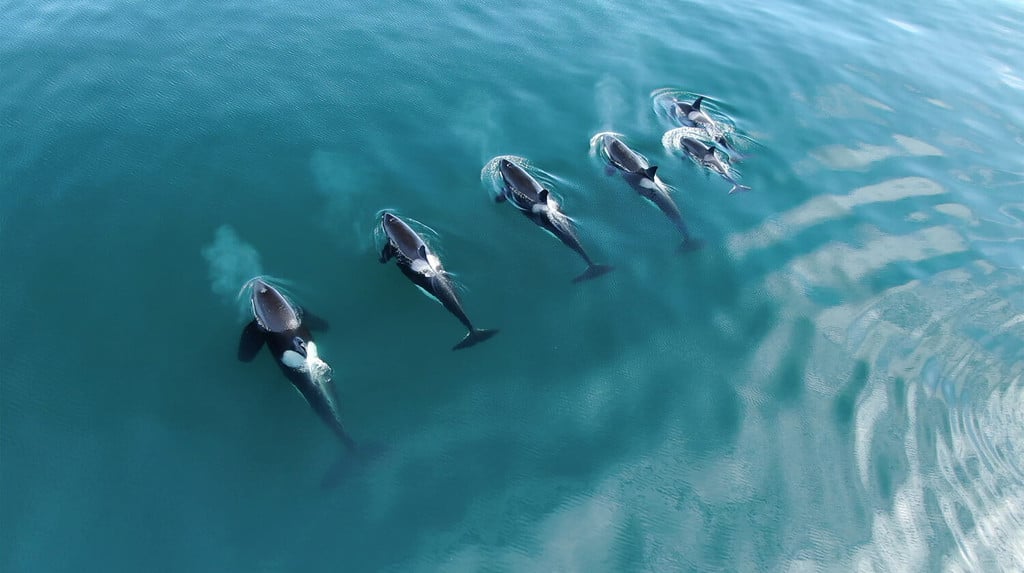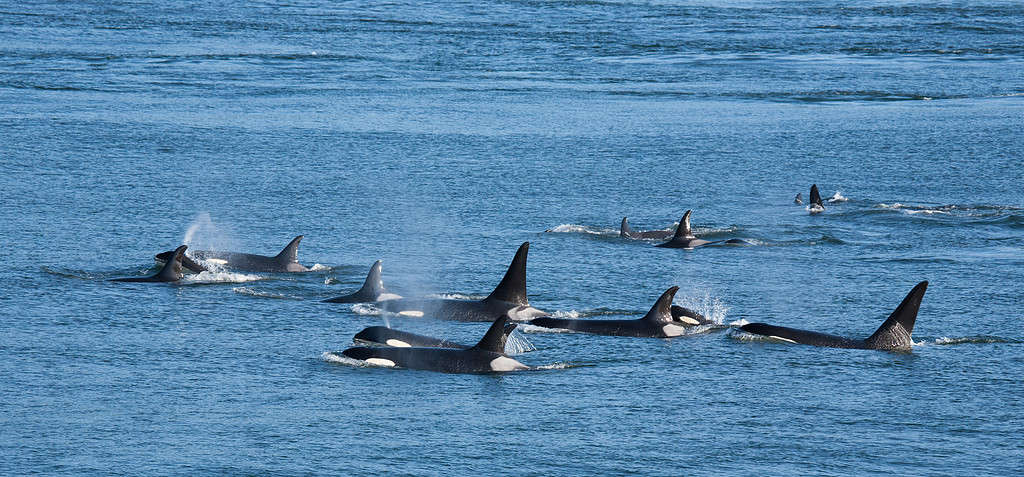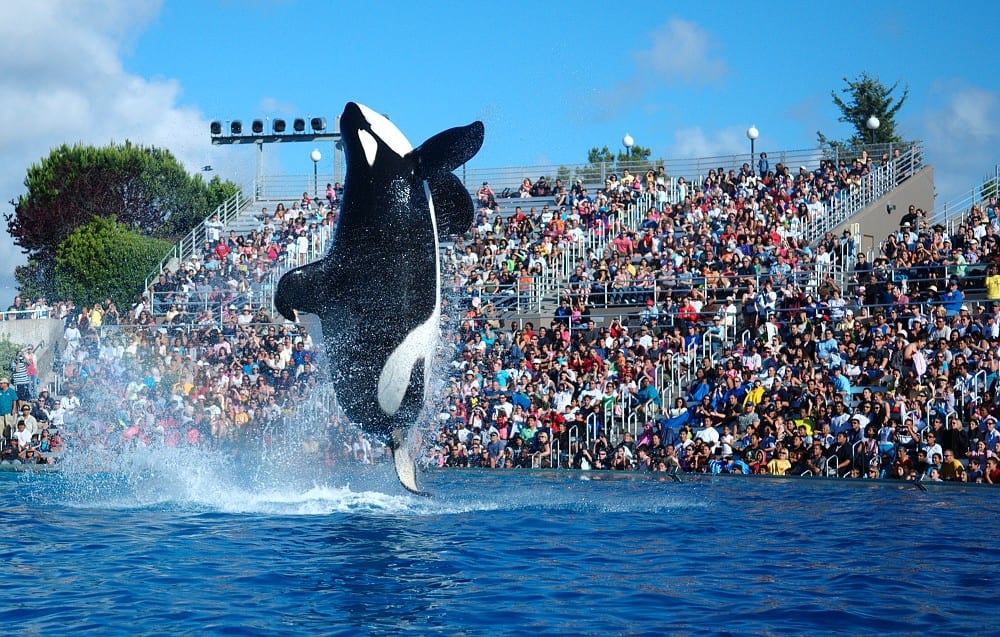Orcas or killer whales are among the most recognizable sea creatures with their black and white coloring. Orcas are the largest of the dolphins and one of the world’s most powerful predators. These intelligent and social mammals live in groups called pods and live up to 50-80 years. Each pod had distinctive noises that its members would recognize even at a distance. Orcas use echolocation to communicate and hunt, using sounds that travel underwater until they encounter objects, then bounce back, revealing their location, size, and shape.
Experts estimate that there are about 50,000 killer whales left globally. About 2,500 killer whales reside in the eastern North Pacific Ocean, home to the most extensively studied killer whale populations. In this article, we will explore the Orca as a species and what has led to Orca or killers becoming an endangered
Orcas
Scientific name: Orcinus orcara

Orcas swim in groups called pods.
©Willyam Bradberry/Shutterstock.com
The Orca (Orcinus orca) holds the position of the ocean’s apex predator. It is the most prominent member of the Delphinidae family, which includes all dolphin species and certain larger species like long-finned pilot whales and short-finned pilot whales, referred to as “whales” instead of “dolphins” in ordinary language.
These remarkable creatures distribute themselves across all the world’s oceans, making them the most widely dispersed cetaceans (whales and dolphins). Extensive scientific research has identified numerous populations and distinct ecotypes (or forms) of killer whales globally, some of which might even represent separate species or subspecies. Their distinctive black and white bodies make them one of the most recognizable marine mammals. Killer whales inhabit diverse habitats, from open seas to coastal waters. As a species, they possess the most varied diet among all cetaceans, but different populations typically exhibit specialized foraging behaviors and dietary preferences. They often employ a coordinated hunting strategy, resembling a pack of wolves working together.
Why Orcas are Threatened
In the past, hunters and fishermen target killer whales. Historical threats to their population included commercial hunting and culling to safeguard fisheries from predation. While life captures for aquariums and marine parks no longer occur in the United States, this practice still poses a threat globally. Killer whale populations confront numerous challenges, such as limited food resources, chemical pollutants, and disruptions caused by vessel traffic and underwater noise. Conservation efforts, including establishing critical habitats, implementing protective regulations, and restoring prey populations, are crucial, particularly for the endangered Southern Resident killer whale population.
The Marine Mammal Protection Act protects all killer whales. However, the following population receive additional special protections under federal law.
Southern Resident Distinct Population Segment (DPS): Scientist list this population as endangered under the Endangered Species Act.

NOAA Fisheries dedicates itself to conserving killer whales and protecting and recovering endangered populations.
©Heather Renee/Shutterstock.com
The Southern Resident killer whales, spanning from central California to southeast Alaska, represent the only endangered population of killer whales in the United States. Safeguarding the Southern Resident population and preventing their extinction necessitates long-term commitments across the state and international boundaries.
These whales are one of NOAA Fisheries’ Species in the Spotlight, an initiative that prioritizes recovery efforts for species at the highest risk of extinction.NOAA Fisheries dedicates itself to conserving killer whales and protecting and recovering endangered populations. Scientists and partners employ innovative techniques to study and safeguard these magnificent creatures. NOAA develops regulatory measures and management plans with partners to protect killer whales and their food sources, reduce oceanic contamination, minimize underwater noise, and raise awareness about these whales and how individuals can support their recovery.
How Many Orcas Are Left Today In The World?
Experts believe an estimated 50,000 killer whales swimming in the oceans today. You can find various populations and ecotypes of killer whales throughout every ocean. The National Oceanic and Atmospheric Administration (NOAA) Fisheries provide estimates of population sizes in their stock assessment reports. Scientists believe an approximate of 50,000 killer whales swim throughout the oceans globally. About 2,500 killer whales reside in the eastern North Pacific Ocean, home to the most extensively studied killer whale populations.

Experts believe there are an estimated 50,000 killer whales left globally.
©iStock.com/cullenphotos
Population Decline
Unfortunately, in recent decades, several killer whale populations have experienced declines, and some have reached endangered status. One example is the AT1 Transients, a group of Transient killer whales in the eastern North Pacific. Since the Exxon Valdez oil spill in 1989, their population has dwindled from 22 to just seven whales. Consequently, in 2004, NOAA Fisheries classified this stock as depleted under the Marine Mammal Protection Act (MMPA) based on the findings of a comprehensive status review.
Scientists have determined that the historical minimum population size of the Southern Residents in the eastern North Pacific was approximately 140 animals. However, due to living captures carried out in the 1960s for marine mammal parks, only 71 individuals remained by 1974. Although there was some population growth during the 1970s and 1980s, peaking at 98 animals in 1995, the late 1990s saw a decline of almost 20 percent, leaving the population with only 80 whales in 2001.
The most recent population census conducted in 2020 reported a count of 72 whales, and since then, three new calves have been born, bringing the struggling population’s total to 75. Recognizing the urgency, in 2003, NOAA Fisheries initiated a research and conservation program with funding from Congress to address the decline. In 2005, the Southern Residents listed them as Endangered under the Endangered Species Act (ESA), and a recovery plan was completed in 2008.
Are Orcas in Danger?

Life captures for aquariums and marine parks no longer occur in the United States but remain a global concern.
©Yathin S Krishnappa, CC BY-SA 3.0, via Wikimedia Commons – Original / License
Orcas are very difficult to study. Currently, the International Union for Conservation of Nature (IUCN) categorizes them as “Data Deficient,” indicating a lack of available information on their population and distribution. Consequently, scientists find it difficult to determine if they are endangered or not and to make accurate assessments. However, it is essential to note that the IUCN has identified a critically endangered subpopulation in the Strait of Gibraltar.
Historically, killer whales have faced threats from hunters and fishermen. Commercial hunting and culling by fisheries posed significant dangers to their populations. While life captures for aquariums and marine parks no longer occur in the United States, it remains a global concern.
Potential Threats to Orcas
Killer whale populations encounter various threats, including food scarcity, chemical pollutants, disturbances from vessel traffic, and underwater noise. To ensure their conservation, it is crucial to establish critical habitats, implement protective regulations, and restore prey populations. The endangered Southern Resident killer whale population, specifically, requires special attention.
The Southern Resident Distinct Population Segment in the United States became endangered under the Endangered Species Act. Scientists also characterized another population, the AT1 Transient stock, as depleted.

Killer whales live in oceans all over the world. They are especially plentiful in the cold waters in the Arctic, Antarctic, and around Norway.
©qingqing/Shutterstock.com
Studying orcas presents significant challenges. Currently, the International Union for Conservation of Nature (IUCN) categorizes them as “Data Deficient,” indicating a lack of available information on their population and distribution. Consequently, scientists find it difficult to determine if they are endangered or not and make accurate assessments.
However, it is essential to note that the IUCN has identified a critically endangered subpopulation in the Strait of Gibraltar.
Historically, killer whales have faced threats from hunters and fishermen. Commercial hunting and culling by fisheries pose significant dangers to their populations. While life captures for aquariums and marine parks no longer occur in the United States, it remains a global concern.
Killer whale populations encounter various threats, including food scarcity, chemical pollutants, disturbances from vessel traffic, and underwater noise. To ensure their conservation, it is crucial to establish critical habitats, implement protective regulations, and restore prey populations. The endangered Southern Resident killer whale population, specifically, requires special attention.
Scientists listed the Southern Resident Distinct Population Segment as endangered under the Endangered Species Act. Scientists also enlisted another population, the AT1 Transient stock, as depleted.
The photo featured at the top of this post is © slowmotiongli/Shutterstock.com
Thank you for reading! Have some feedback for us? Contact the AZ Animals editorial team.







